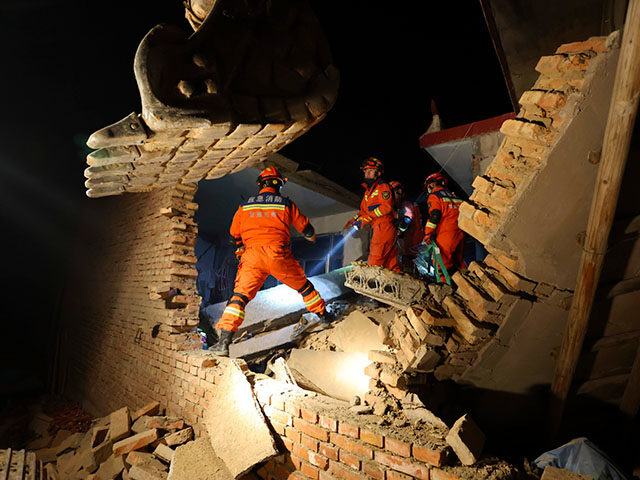The Chinese Communist Party has documented the deaths of 127 people as of press time Tuesday and hundreds of injuries as a result of a series of earthquakes in northern Gansu province, the largest of which measured 6.2 magnitude.
The death toll already makes it the deadliest earthquake in China since 2010 and is expected to grow as several of the injured are in critical condition and many locals are missing under rubble.
The state-run Global Times newspaper reported that the region, for decades one of China’s most impoverished, is home to a large number of buildings with “poor seismic resistance” in high-density population areas, elevating the casualty count and necessitating the deployment of thousands of emergency personnel, including People’s Liberation Army (PLA) forces, to erect temporary shelters and save those trapped in rubble. Most of the deaths reported were in Gansu, though at least 14 people also died in nearby Qinghai province.
The largest earthquake reportedly struck around 3 a.m. local time – meaning most people were in their homes when it occurred – and reportedly destroyed “thousands” of residences, leaving thousands displaced in the dead of winter. Gansu is located in north-central China, bordering Inner Mongolia and typically experiences brutally cold winters.
“The most urgent task for us is to make things ready quickly as temperatures will reach -17 C (1.4 degrees Fahrenheit) tonight,” an unnamed emergency response volunteer told the Agence France-Presse (AFP). The regional infrastructure is reportedly devastated, leaving many with no electricity or heat even if they felt safe enough to reenter damaged buildings.
China experienced record-low temperatures in 23 different regional capitals this weekend, reportedly causing disruptions in local hospitals and fears that power plants and heat supplies would dwindle. Chinese state media insisted the country was prepared for the cold wave as it had stockpiled tremendous amounts of coal, defying global environmentalist calls to curb carbon emissions.
The hospitals, reports from China warned, were experiencing low rates of blood donation, which jeopardizes the ability of the hospitals to respond to emergencies. For much of November, hospitals faced significant overcrowding as a result of the spread of respiratory disease, which Beijing insisted was caused by known pathogens such as influenza, Wuhan coronavirus, and mycoplasma pulmonae. Medical experts attributed the uptick in child pneumonia in particular to China’s “zero-covid” house arrest and quarantine camp policy in the aftermath of the initial Wuhan disease outbreak, which kept the public from being exposed to pathogens at typical rates that help boost the immune system.
Video out of Gansu showed buildings with cracked ceilings, trembling businesses and malls, and rescuers attempting to find people in piles of debris.
AFP and Chinese news outlets reported terrified residents running out of their homes as the earthquake struck. In Dahejia, the town closest to the epicenter, the Chinese regime outlet Xinhua quoted a local student who said he ran “out of the dormitory barefoot, without even grabbing a coat.” Dahejia is in the Hui autonomous region, home to the majority of the nation’s Muslim Hui ethnic minority.
Another survivor speaking to the Global Times recounted grabbing their family and rushing down 16 flights of stairs.
“I live on the 16th floor and felt the tremors so strongly. The moment of the earthquake was feeling like being tossed up after surging waves,” the survivor, identified only as “Qin,” told the state outlet. “I woke my family up and we rushed down all 16 floors in one breath.”
“Xinhua reporters arrived at the severely affected Chenjia village in Dahejia township in Gansu at around 3 a.m. Tuesday, finding the village plunged into darkness as a blackout gripped the area, and electricity cables dangled on the ground,” the outlet detailed. “Several houses had crumbled, leaving streets strewn with shards of glass, bricks and rocks.”
Images circulating through Chinese dissident outlets also revealed locals fearing further deaths through the destruction of local infrastructure. In a message published by the anonymous dissident account “Teacher Li Is Not Your Teacher,” one local from the village of Dongtian warned that a local canal appeared to have been damaged in the quake and caused Yellow River water to flood into local valleys. The mudslides reportedly resulted in the disappearance of at least 20 people, the report claimed, adding that emergency relief services had yet to arrive at the time of the publication on Monday.
12月19日,青海省。一网友发贴求助称,青海省东田村地震使大干渠开裂,黄河分支水从山上冲下来,变成泥石流,据当地的村民说已经有20多人失联了,而且现在还缺物资和救援人员。 pic.twitter.com/nuQHcvLxDg
— 李老师不是你老师 (@whyyoutouzhele) December 19, 2023
The Global Times reported that the regime had documented “mountain collapses” in Gansu and “displacement in the supports of a local bridge,” corroborating local infrastructure concerns.
“Teacher Li” also published images that appeared to show locals collecting blankets and other emergency relief and distributing it on their own, as Chinese government volunteers had yet to arrive.
12月19日,甘肃省临夏州积石山县,有民众自费运了一车棉服棉被等物资到现场 pic.twitter.com/vT4mI0PeW4
— 李老师不是你老师 (@whyyoutouzhele) December 19, 2023
The Communist Party claimed it has dispatched thousands of relief workers and “urgently allocated 200 million yuan ($28 million) in disaster relief funds to northwest China’s Gansu and Qinghai provinces” as of Tuesday.

COMMENTS
Please let us know if you're having issues with commenting.